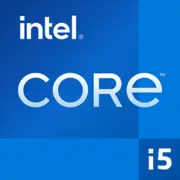Intel Core i5-1340P

Intel Core i5-1340P: A Versatile Processor for Mobile Tasks in 2025
Architecture and Manufacturing Process: Hybrid Cores and the Evolution of Raptor Lake
The Intel Core i5-1340P processor belongs to the Raptor Lake generation and is built on Intel's 10nm process technology known as Intel 7. Its hybrid architecture combines two types of cores:
- 4 performance cores (P-core) (Golden Cove) with Hyper-Threading support (8 threads), running at a base frequency of 1.9 GHz and a maximum turbo frequency of 4.6 GHz.
- 8 efficient cores (E-core) (Gracemont) without Hyper-Threading (8 threads), with a frequency of up to 3.4 GHz.
This results in a total of 16 threads and an increased L3 cache of 12 MB. This setup allows for efficient task distribution: P-cores handle demanding applications, while E-cores manage background processes, reducing power consumption.
The integrated Intel Iris Xe graphics with 80 Execution Units (EU) supports 4K displays, AV1 decoding, and technologies like DLSS for gaming. The GPU frequency reaches 1.45 GHz, making it one of the fastest integrated GPUs in its class.
Power Consumption and TDP: Balancing Performance and Battery Life
The processor's TDP is 28W, which classifies it as a chip suitable for thin ultrabooks and business laptops. However, actual power consumption can vary from 20W (in power-saving mode) to 40W in turbo mode. This necessitates a high-quality cooling system: even in compact devices, dual-fan setups or heat pipes with copper radiators are often used.
Power optimization features include:
- Intel Dynamic Tuning — automatic voltage and frequency adjustments based on load.
- Adaptix Technology — pre-set performance profiles from OEM manufacturers.
Performance: From Office Tasks to Gaming
- Office Tasks: In PCMark 10 tests, the i5-1340P scores ~5200 points, ensuring smooth operation with browsers (30+ tabs), Microsoft 365, and video conferencing.
- Multimedia: Rendering a 10-minute video in DaVinci Resolve takes about 8 minutes (compared to 12 minutes for the i5-1240P). AV1 hardware decoding reduces CPU load when watching streams.
- Gaming: In Dota 2 (1080p, medium settings), Iris Xe achieves a steady 60 FPS, while in Fortnite (720p, low settings), it runs at around 45 FPS. For AAA titles, an external GPU or discrete graphics is necessary.
- Turbo Mode: Under short-term loads (like launching Photoshop), P-cores can boost up to 4.6 GHz, but after 28 seconds, the frequency drops to 3.8 GHz due to overheating. In laptops with enhanced cooling (like the Lenovo ThinkPad T16), turbo mode lasts longer.
Usage Scenarios: Who is the i5-1340P Suitable For?
1. Office Workers and Students — multitasking, working with cloud services.
2. Creative Professionals — editing short videos, processing photos in Lightroom.
3. Travelers — balancing battery life and performance.
4. Casual Gamers — games like CS2 or Minecraft.
The chip is not suitable for 3D rendering in Blender or 4K streaming — for those tasks, it's better to consider the H-series (e.g., i7-13700H).
Battery Life: How Long Will the Laptop Last?
With a battery capacity of 60 Wh:
- Web browsing (brightness at 150 nits) — up to 9 hours.
- Video playback (local 1080p) — around 12 hours.
- Heavy workload (Premiere Pro) — 2.5 to 3 hours.
Energy-saving features include:
- Intel Speed Select — disabling "excess" cores under low load.
- Deep Learning Boost Generation — accelerating AI tasks with reduced power consumption.
Tip: In Windows 12, use the "Efficiency" mode and limit the frequency to 80% in power settings — this can extend battery life by 15-20%.
Comparison with Competitors
- AMD Ryzen 5 7640U (Zen 4): Better multi-threaded performance (Geekbench 6 Multi — 9010), but weaker integrated GPU (Radeon 740M). Suitable for programmers. Laptop prices: from $900.
- Apple M2: More energy-efficient (up to 18 hours of battery life), but limited compatibility with Windows software. Not suitable for gaming. MacBook Air prices: from $999.
- Intel Core i5-1240P: Outdated Alder Lake architecture. Multi-threaded Geekbench 6 score — 7210, which is 14% slower than the i5-1340P.
Pros and Cons
Strengths:
- Ideal for hybrid work (office + mobility).
- Powerful integrated graphics.
- Support for Thunderbolt 4 and Wi-Fi 6E.
Weaknesses:
- Heating in turbo mode (up to 95°C in thin chassis).
- Lacks the performance for professional 8K editing.
Recommendations for Laptop Selection
1. Chassis and Cooling: Look for models with aluminum cases and dual fans (e.g., Asus ZenBook 14X). Avoid devices thinner than 15 mm, as they tend to throttle.
2. Screen: For color work — IPS panels with 100% sRGB coverage (Dell XPS 13). For battery life — FHD+ resolution panels.
3. Battery: Optimal capacity is 60-70 Wh. Laptops with 4K screens drain 30% faster.
4. Price: Devices with the i5-1340P range from $850 (Acer Swift 5) to $1300 (HP Spectre x360 with OLED screen).
Final Conclusion
The Intel Core i5-1340P is a suitable choice for those needing a versatile laptop without compromises. It handles work, study, and light creative tasks well, provides 8-10 hours of battery life, and does not overheat under moderate loads. If you are not a gamer or 3D designer, this processor will be a reliable partner for the next 3-4 years. Key advantages include its hybrid architecture, support for modern communication standards, and class-leading graphics.
Basic
CPU Specifications
Memory Specifications
GPU Specifications
Miscellaneous
Benchmarks
Compared to Other CPU
Related CPU Comparisons
Share in social media
Or Link To Us
<a href="https://cputronic.com/cpu/intel-core-i5-1340p" target="_blank">Intel Core i5-1340P</a>

